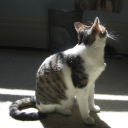- Home
- /
- Programming
- /
- ODS Reports
- /
- Re: ODS SELECT Histograms statement - Will not re-use a specified name
- RSS Feed
- Mark Topic as New
- Mark Topic as Read
- Float this Topic for Current User
- Bookmark
- Subscribe
- Mute
- Printer Friendly Page
- Mark as New
- Bookmark
- Subscribe
- Mute
- RSS Feed
- Permalink
- Report Inappropriate Content
Hi,
I'm having a play with the ODS SELECT Histograms statement to get Proc Univariate to produce a table after the histogram that shows the bin sizes used by the histogram. I got the idea from the SAS documentation (see: Binning a Histogram at: http://support.sas.com/documentation/cdl/en/procstat/63104/HTML/default/viewer.htm#procstat_univaria...)
The first time I run my playground code shown below, I get exactly what I want, and I am very happy. However, on subsequent runs in the same SAS session, exactly the same code produces a NOTE and a WARNING indicating that the ODS object name is already in use and that SAS has added a numeric suffix to it.
My playground code looks like this and as it uses SASHELP.SHOES, you too can join in the fun !
*******************************************************************;
*Create a sub-set of SASHELP.SHOES for Sales between $10k and $100k;
*******************************************************************;
Data WORK.SHOES;
Set SASHELP.SHOES;
Where SALES Between 10000 And 100000;
Run;
******************************************************************;
*Tell ODS to produce a handy table of Histogram Bin sizes after ;
*the actual Histogram has been produced. ;
******************************************************************;
ODS SELECT HistogramBins MyBins;
******************************************************************;
*Tell Proc Univariate to write the bin size information out to ;
*MyBins. ;
******************************************************************;
Title "Proc Univariate Histogram showing distribution of SALES for a sub-set of SASHELP.SHOES";
Proc Univariate Data=WORK.SHOES NoPrint;
Var SALES;
Histogram / MIDPERCENTS NAME="MyBins"
ENDPOINTS = 10000 to 100000 by 10000;
Run;
Quit;
When I first run the above code, the SASLOG from the Proc Univariate reports:
NOTE: 9867 bytes written to
/saswork_user/SAS_work1DF00000C36C_biffo.co.nz/SAS_work29E00000C36C_biffo.co.nz/mybins.png.
NOTE: PROCEDURE UNIVARIATE used (Total process time):
real time 0.36 seconds
cpu time 0.26 seconds
and my output is just what I want, one histogram and one bin size table courtesy of the:
ODS SELECT Histograms MyBins
statement.
However, when I run this same code again (including the ODS SELECT Histograms MyBins bit) I get the following in the SASLOG:
NOTE: Graph's name, MYBINS, changed to MYBINS1. MYBINS is already used or not a valid SAS name.
WARNING: Output 'MyBins' was not created. Make sure that the output object name, label, or path is spelled correctly. Also,
verify that the appropriate procedure options are used to produce the requested output object. For example, verify that
the NOPRINT option is not used.
NOTE: PROCEDURE UNIVARIATE used (Total process time):
real time 0.10 seconds
cpu time 0.11 seconds
So far as I can tell, SAS seems unwilling to overwrite the original mybins.png that it created after the first run and placed into the directory that hosts the WORK library..
The only workaround I can think of is to comment out the ODS SELECT Histograms MyBins for subsequent re-runs, which is messy or make a macro variable that uses the run-time to provide a unique suffix to stick on the end of MyBins which is a bit overblown.
I'm pretty sure that there is actually a much simpler and robust way of overcoming this problem, maybe a second statement to submit after the Proc Univariate to disassociate the name MyBins. so that it can be used on re-runs of the code.
I am using:
SAS 9.04.01M3P062415
SYSHOSTINFOLONG reports: Linux LIN X64 2.6.32-642.4.2.el6.x86_64 #1 SMP Mon Aug 15 02:06:41 EDT 2016 x86_64 Red Hat Enterprise Linux Server release 6.8 (Santiago)
Does anyone have any ideas on this one ?
Many thanks,
Downunder Dave.
Wellington
Accepted Solutions
- Mark as New
- Bookmark
- Subscribe
- Mute
- RSS Feed
- Permalink
- Report Inappropriate Content
- Mark as New
- Bookmark
- Subscribe
- Mute
- RSS Feed
- Permalink
- Report Inappropriate Content
- Mark as New
- Bookmark
- Subscribe
- Mute
- RSS Feed
- Permalink
- Report Inappropriate Content
You might also use SGPLOT and ODS Graphics instead of legacy GRSEG graphics in UNIVARIATE.
- Mark as New
- Bookmark
- Subscribe
- Mute
- RSS Feed
- Permalink
- Report Inappropriate Content
Hi Warren,
Thanks for your pointer.
Although I had been using the NAME= option I had been getting confused as to which item the SASLOG was referring to, I had been thinking that the binning table that ODS was generating had been the cause of the problem. However, your gentle nudge about using GRSEG graphics got me looking much closer and I realised that the message in the SASLOG was referring to the MYBINS item in the WORK.GSEG catalog and not the HistogramBins output table provided by ODS.
I've now implemented a conditional delete via Proc Catalog to remove any instances of the output item that I am just about to recreate so that my SASLOG is NOTE and WARNING free and that there is only one instance of the item in the catalog and not a series of similarly named items, MYBINS, MYBINS1, MYBINS2,.......MYBINSn etc.
Many thanks for your help.
Downunder Dave
Wellington
April 27 – 30 | Gaylord Texan | Grapevine, Texas
Registration is open
Walk in ready to learn. Walk out ready to deliver. This is the data and AI conference you can't afford to miss.
Register now and save with the early bird rate—just $795!
Learn how use the CAT functions in SAS to join values from multiple variables into a single value.
Find more tutorials on the SAS Users YouTube channel.
SAS Training: Just a Click Away
Ready to level-up your skills? Choose your own adventure.



